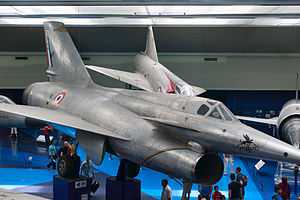Nord 1500 Griffon
| 1500 Griffon | |
|---|---|
 | |
| Griffon II | |
| Role | Research fighter |
| National origin | France |
| Manufacturer | Nord Aviation |
| First flight | 20 September 1955 (Griffon I), 23 January 1957 (Griffon II) |
| Number built | 2 |
|
| |
The Nord 1500 Griffon was an experimental ramjet-powered fighter aircraft designed and built in the mid-1950s by French state-owned aircraft manufacturer Nord Aviation. It was part of a series of competing programs to fill a French air force specification for a Mach 2 fighter.
Design and development
Design of the Griffon originated in a late 1940s requirement for a high speed interceptor. Engineers at Arsenal de l'Aéronautique instigated studies into swept and delta wings using supersonic gliders, the Arsenal 1301 and Arsenal 2301. Results from these flight tests favoured the delta configuration, which was incorporated into design studies using a variety of power-plants. By this time Arsenal had been privatised as SFECMAS - Société Française d'Etude et de Construction de Matériel Aéronautiques Spéciaux. Powered by a large ramjet with turbojet sustainer, the Griffon was renamed from the SFECMAS 1500 Guépard (Cheetah) after SFECMAS was merged with SNCAN to form Nord Aviation.[1]
Two prototypes were ordered initially in a letter dated 24 August 1953, with the final contract, (No. 2003/55) in 1955. Although intended to eventually fulfil a requirement for a light interceptor capable of operation from 1,000m grass runways, the two prototypes were ordered without military equipment for research purposes only.[2]
Constructed mainly of light alloys, the Griffon comprised a large tubular fuselage which supported the middle set delta wings, fin with rudder and the forward fuselage, which extended forwards over the turbo-ramjet air intake. The forward fuselage housed the single seat cockpit and carried small delta canards either side of the cockpit. The tricycle undercarriage retracted into the wings and the underside of the air intake.[2]
The design of the Griffon featured a dual turbojet-ramjet powerplant, with the turbojet enabling unassisted take-offs (ramjets cannot produce thrust at zero airspeed and thus cannot move an aircraft from a standstill) and the ramjet producing extra thrust at airspeeds above 1,000 km/h (600 mph). To reduce risks in using the relatively new Turbo-ramjet powerplant, the first Griffon (Nord 1500-01 Griffon I) was completed with only the 3,800 kgf thrust ATAR 101F turbojet component. First flown by Andre Turcat on 20 September 1955, the Griffon I proved to be underpowered but plans to install the planned ramjet component were never realised. Despite the lack of power the Griffon I still managed to reach M1.7. Flying with the Griffon I ceased in April 1957 in favour of the ramjet equipped Griffon II. Visible differences between the two aircraft were limited to the smaller intake and two position exhaust nozzle of the Griffon I.[3]
Operational history
After proving the aerodynamic aspects and systems of the Griffon, the 1500-01 was retired in April 1957. Flying continued with the Griffon II after its first flight on 23 January 1957. With Major André Turcat at the controls, the Griffon II reached a top speed of Mach 2.19 (2,330 km/h or 1,450 mph) in 1958, thus proving the soundness of the basic design. But the aircraft met several technical difficulties, such as kinetic heating, due to the lack of temperature resistant materials, such as Inconel or Titanium, in the parts of the airframe experiencing the highest temperatures. The ramjet was found to work well at high speed, but was unstable at medium speeds.[3]
Production of operational versions, dubbed Super Griffon did not take place as it was found that the requirements could be met and exceeded with less complex and cheaper aircraft such as the Dassault Mirage III.[4]
Variants
- SFECMAS 1500 Guépard
- The original designation and name of the initial design studies carried out at SFECMAS.[1]
- Nord 1500-01 Griffon I
- The first aircraft completed with only the ATAR 101F afterburning turbojet component of the planned turbo-ramjet powerplant.[2]
- Nord 1500-02 Griffon II
- The second aircraft fitted with the definitive turbo-ramjet powerplant.[3]
- Nord Super Griffon
- A projected scaled up operational development of the Griffon II, with a 2m diameter ramjet and retractable canards, intended to reach M3, constructed mainly of stainless steel.[4]
Aircraft on display
A preserved Nord 1500-02 Griffon II aircraft is on display in the French Air and Space Museum, at Le Bourget, near Paris.[4]
Specifications (Nord 1500-2 Griffon II)
Data from Jane's[5]
General characteristics
- Crew: 1
- Length: 14.54 m (47 ft 8.5 in)
- Wingspan: 8.10 m (26 ft 7 in)
- Height: 5.00 m (16 ft 5 in)
- Wing area: 32 m² (344.5 sq.ft)
- Loaded weight: 6,745 kg (14,839 lb)
- Powerplant:
Performance
- Maximum speed: Mach 2.19 (2,330 km/h)
See also
- Related development
- Aircraft of comparable role, configuration and era
- Hawker P.1121
- Saunders-Roe SR.53
- Saunders-Roe SR.177
- SNCASO Trident
- XF-91 Thunderceptor
References
Notes
- ↑ 1.0 1.1 "L’Arsenal de l’aéronautique" (PDF). www.hydroretro.net. 2007-08-18. Retrieved 2011-06-16.
- ↑ 2.0 2.1 2.2 "Griffon overview". jpcolliat.free.fr. 2003-04-30. Retrieved 2011-06-16.
- ↑ 3.0 3.1 3.2 "Griffon II". jpcolliat.free.fr. 2003-04-30. Retrieved 2011-06-16.
- ↑ 4.0 4.1 4.2 "Griffon derivatives". jpcolliat.free.fr. 2003-04-30. Retrieved 2011-06-16.
- ↑ Taylor 1976, p. 167.
Bibliography
- Taylor, John W.R. Jane's Pocket Book of Research and Experimental Aircraft, London, Macdonald and Jane's Publishers Ltd, 1976. ISBN 0-356-08409-4.
External links
| Wikimedia Commons has media related to Nord 1500. |
- Overview of the Griffon program (in French)
- Griffon II
- Griffon derivatives
- EADS - Nord 1500
- Arsenal de lÁeronautique
- turbo-ramjet genesis
| ||||||||||||||||||||||||||||||||||||||||||||
| ||||||||||||||||||||||